Ruth C. White on YouTube and Being on TV
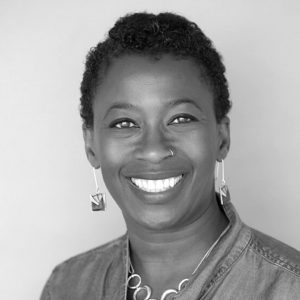
Dr. Ruth C. White found you don’t need a big audience on YouTube to reach the right people. In fact, her 1st YouTube video landed her on national television.
YouTube is the most popular social media platform academics aren’t really using. That’s why I’m so excited to share this feature interview guest with you.
In this chat, Ruth and I talk about
- her work as a mental health advocate and Clinical Associate Professor
- how she got started on YouTube and why
- how her 1st YouTube video landed her on The Today Show
- booking tv spots
- YouTube tips for you
When I conducted this interview, I was just getting ready to launch my own YouTube channel. And I was still very anxious about being on video.
You can see in this interview how her advice helps me in real time (like when I stop looking at my paper to ask questions). That’s why I know this interview will be great for you too.
I’m Jennifer van Alstyne and welcome to The Social Academic blog. Twice a month, I share advice articles on managing your online presence, and interviews with cool grad students and academics like you.
Let’s dive into this in-depth interview with Dr. Ruth C. White.
Subscribe to The Social Academic blog.
The form above subscribes you to new posts published on The Social Academic blog.
Want emails from Jennifer about building your online presence? Subscribe to her email list.
Looking for the podcast? Subscribe on Spotify.
Prefer to watch videos? Subscribe on YouTube.
Meet Ruth C. White, PhD
Listen to ‘A Chat with Ruth C. White About YouTube’
Subscribe to the podcast on Spotify | YouTube | TuneIn | ListenNotes | Blubrry
Jennifer: All right. Hi everyone. My name is Jennifer Van Alstyne and today I’m talking with Dr. Ruth C. White.
Hi, Dr. White, could you please introduce yourself?
Ruth: Hi, I’m Dr. White and I am a Clinical Associate Professor in the Suzanne Dworak-Peck School of Social Work at the University of Southern California. I consider myself a mental health advocate, DEI consultant and a bit of an adventurer.
Jennifer: I love it. Could you tell me a bit more about your role as a clinical associate professor?
Ruth: I teach graduate students, so MSW students. I teach them leadership, management, social policy, and I’ve been doing that for a very long time, probably more than 20 years. So UAC is my latest position, I’ve been here for seven years. Prior to that, I got tenure at Seattle U and I taught at San Francisco State. And I’ve also taught courses at Berkeley and Fordham.
Jennifer: So all over?
Ruth: Yeah. And I’ve been teaching social work students since I was a graduate, since I was an MSW student in 1991 at McGill. So yeah, that’s my day job. And then out of that work as a professor, comes my work as an advocate around mental health, etc.
Subscribe to The Social Academic blog.
The form above subscribes you to new posts published on The Social Academic blog.
Want emails from Jennifer about building your online presence? Subscribe to her email list.
Looking for the podcast? Subscribe on Spotify.
Prefer to watch videos? Subscribe on YouTube.
Ruth is a professor, diversity trainer, stress management expert, and mental health activist

Jennifer: That’s amazing. And that’s totally why I invited you on this show, so I’m excited that you joined us. You’re also a diversity trainer, stress management expert and mental health activist, is that right?
Ruth: Yeah. I started getting into diversity work as an intern. I was a social work intern at a black community center in Montreal when a young black man got shot by the police, that was 1988.
And because I worked at black community center at the time, we were working with the police to improve police-community relationships, and so I worked with the police on that. I ended up actually going into a policing conference in Florida back in 1989 or so. And so that got me into that.
Also, my master’s in social work, my thesis was to look at the disproportionality in terms of disposition in juvenile justice. So my master’s internship was at a… I did probation and did court diversion programs. And so my study at the time was a first to actually quantify the disproportionality, comparing white youth to youth of color. And so that’s the foundation of how I got into DEI work.
And then my first grad student teaching position was teaching a multicultural social work class at McGill. From there, I taught a course in, now we call it DEI, but I can’t remember exactly what we called it then, but I did that for Seneca College, which is a two year college in Toronto in a social services technician program. When I was a grad student at Berkeley, I taught classes in race, ethnicity and culture at San Francisco State for 3 years to both graduate and undergrads. And then I did the same at Seattle University, I taught race, ethnicity, culture, gender, those kinds of courses. So that’s part of my diversity work.
In terms of mental health advocacy, I’m a social worker so that was par for the course as well, but I had a personal connection.
I have bipolar disorder. And, just the way that I had to process that career-wise or professionally and learning a lot about the illness, I wrote my first book as part of that, which as a social worker, I’m not the mental health side, I was more of a community person. And I ended up writing a book because I learned so much about brain function and how to manage mental health outside of just medications.
And so that was my first book. And now four books later, I’m still writing about mental health even though that was not exactly my training.
Like I said, I am a social worker, so that is part of it. But it was my own personal experience that brought me to the advocacy side as well because I realized that there was a lot of stigma, a lot of barriers to care, a lot of not understanding around how people experience symptoms. The cyclical nature of it, so that people are not always active in symptoms, whereas often they get treated that way.
If you say you have schizophrenia, people just think that you always are seeing things or you’re always hearing things and they don’t really recognize that part of the illness. So I think that gets up most of it.
Public health work really grew out of my work with mental illness because stress is such a trigger for mental health problems. And so as a public health person, I got focused on prevention. So I felt like, “Well, it’s one thing to get treatment, but how do we prevent people from having mental health issues?”
And as I did my research, I realized that the number one reason people go to their doctor is stress-related conditions. And how significant it is to our health if we learn to manage the stress in our lives.
Jennifer: Thank you so much for sharing that background, and also the personal side of what inspired you, I think that’s so important for motivation. And also it sounds like the drive that brought you focus in each of those positions and moved you forward.
Subscribe to The Social Academic blog.
The form above subscribes you to new posts published on The Social Academic blog.
Want emails from Jennifer about building your online presence? Subscribe to her email list.
Looking for the podcast? Subscribe on Spotify.
Prefer to watch videos? Subscribe on YouTube.
From university radio show to starting her YouTube channel

Jennifer: I reached out to you for this interview because a few months ago, I saw a post that you shared on Instagram, where you were talking about why you created your YouTube channel. You said that you wanted to get on TV, and so you started a YouTube channel and you actually got to The Today Show from your very first video.
Ruth: Yes.
Jennifer: Tell me more about starting that YouTube channel.
Ruth: I was not a person that watched a lot of YouTube, so that’s what to me just… In my head, when I think back, I just remember when I was first at Seattle U, right after graduating from Berkeley, I wanted to do a radio show and there was the opportunity to do so at Seattle University, which is very unusual. There weren’t any other professors actually running a show, it’s a student-led radio station.
And so I decided that I wanted to do a social policy show because I taught social policy. And I thought it would be great to be able to teach people about various social policies.
And so I learned the production and I produced the show myself. I couldn’t find a student to help me, so I produced the show myself including
- getting guests
- booking guests
- writing the scripts
- doing the ads
all of that while I was trying to get tenure.
The show lasted about 6 months before… I knew that it wasn’t going to get a lot of value in terms of my professional career, and it was just taking out a lot of time.
Jennifer: Too much time.
Every woman I know was sharing a story, how #MeToo inspired Ruth’s 1st YouTube video

Ruth: Right. So that just sat there. And then I started to think about YouTube because I had something I wanted to say and I just felt like recording it. And so it happened around the Me Too movement. What happened literally, triggered me was, I was reading Facebook comments from a lot of my male friends and all my male friends denied ever doing anything inappropriate with a woman.
Jennifer: Like ever?
Ruth: It was like, “No, I knew people who did it, but not me and not my friends. I’ve never grabbed a boob, I would never do that, I would never disrespect a woman.”
Now, I thought it was hilarious because I knew some of these men and they had done it to me when I was younger because that was the norm at the time.
But just the fact that every woman I know was sharing a story, like literally, I had never met a woman that had said, “I’ve never gotten harassed by them.” And yet, no man was claiming responsibilities.
So for me, it was there’s this disconnect between all these women saying, “This would happen to me,” and all these men going, “Not me, just this dude who’s on TV or who’s in the newspapers.”
And so I just literally sat down and I just ranted, and my friends liked it and they’re like, “Oh my God, it’s so you,” because that’s how I am, like certainly I just get a bug up my butt and I-
Jennifer: You have to get it out there.
Ruth: And I had to get it out there.
How blogging and commentary led to Ruth being on national TV

Ruth: And I used to write all the time, so I had a Psychology Today blog and I actually had two other blogs because I like to write. And that’s the thing, I usually have an opinion about things.
And so I had this blog that I had called Provoking Policy, and I would just spew on whatever policy I wanted to spew on. So that was a blog that I had on BlogSpot for years, I think I started maybe 11, 12 years ago.
And then I always say like, people say, “Why aren’t you coming to continue?” And my thing was, “I say what I had to say.” I just didn’t have that much more else to say, I commented on the things that were important to me.
And so I had the Psychology Today blog as well, and I had written pieces around sexual behavior. Even though it was culture, Psychology Today came to me and asked me to write a blog around culture, mental health. And I called it Culture Broadly Defined.
So I was writing about gender roles and the way that sex as part of that.
And so I did that [YouTube] video.
And then as part of my Psychology Today blog, so I was doing freelance, I was just messing around on Upwork, which is a freelance platform, and somebody asked me to write a blog post for them around toxic masculinity in adolescent boys. And all they wanted me to do was just to put a live link to their resource. And I got paid to write that blog, not a lot, I think it was $100.
So between those two things, The Today Show found me and they wanted me to comment on toxic masculinity among adolescents.
So I got interviewed by Maria Shriver. I live in Oakland, so I teach online. I flew down to LA because it was on the USC campus.
And it was an interesting process, they screened me wanting to know what my opinions and stuff work because I was outspoken on this video. And then I flew down to LA and Maria Shriver interviewed me and we recorded that.
And the link is no longer live because they have so much shift in those things in terms of volume, but it taught me that it really didn’t matter how many people saw my video, it was who saw my video.
Because at the time that they reached out, I think 200 people had seen the video.
It didn’t go viral, it didn’t have 100,000 people looking at it. To this day, it doesn’t have 1,000 people that saw it. I don’t even think it has 500, maybe 500 people. And then the blog posts, I don’t know, 2,000 people at the time I’d seen it.
So it was just one of these things where it taught me a lesson about the way I kept perceiving social media, which was that you needed a large following for it to have impact or for the right people to see it.
Subscribe to The Social Academic blog.
The form above subscribes you to new posts published on The Social Academic blog.
Want emails from Jennifer about building your online presence? Subscribe to her email list.
Looking for the podcast? Subscribe on Spotify.
Prefer to watch videos? Subscribe on YouTube.
They reached out to book Ruth for TV from a blog post and a video

Jennifer: What’s really remarkable about what you just said is that it sounds like they got in touch with you based on just two things, right?
Ruth: Yeah. Because I’m not a gender scholar and in fact it was funny because Maria Shriver, because you have to prep for the interview, so before the actual recording, she just figures out what she’s going to ask and etc. And she asked me, she goes, “So you’re a gender scholar?”
And I was like, “No, I’m not. That’s not what I do. I’ve never done research that’s focused on gender.” Like I said, I’ve written and I taught, but it’s commentary that I was writing. And I taught gender in college, like race, gender in class in terms of framework for analysis and US history, but it’s not what I do. It’s what I talk about.
And so that was fascinating to me because I think her expectation was that I was a professor of women’s studies, feminist studies or gender, whatever. And I wasn’t. I think I’ve taken one class that has to do with gender, and that was economics of gender and family class that I took as a tenured professor. I actually went to the grad class because it’s always been an area of interest. So for me that was a learning experience because I also recognize that our voices can reach into corners through social media in ways that traditionally it would have been hard to.
So without these sorts of outlets, I would have never been considered for something like that because that was not my area of… I think it’s my area of expertise, but it was not the area I studied.
Jennifer: Right. And not the area that is most prominent on say, your CV or your faculty profile.
Ruth: Exactly.
Jennifer: So it sounds like just a Google search really was able to connect the right people with the right person to be an expert guest.
That’s exactly the type of thing that I like to talk about in terms of social media, how connecting with a smaller, but more focused audience can be super beneficial. So I was so excited that you decided to join me on the show.
Rant Rave Reason is a vlog-style YouTube channel that shares social commentary
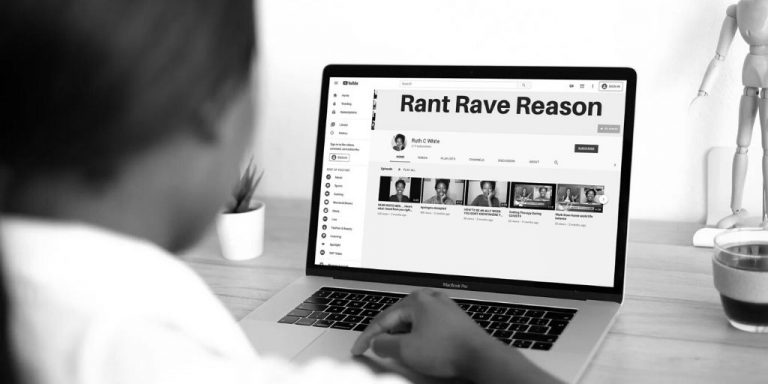
Jennifer: I’d like to talk more about your YouTube channel because we talked about that first video. Tell me more about your channel, it’s called Rant.Rave.Reason. What kinds of videos do you share?
Ruth: When I first started out, it was funny because my daughter thought I looked too professorial. She’s like, “Nobody wants to see you read something off of… ” What do you call it? Teleprompter. Because I actually downloaded teleprompter little app and everything.
She was like, “Mom… ” She’s in her young 20s, so for her, YouTube is what they watch, they consume a lot in YouTube. And she’s like, “Mom, people just sit on their sofa and have a conversation with people and that resonates.”
And so in the beginning, I actually had a few ideas about the name, and I went on Facebook and I said to my friends, “Which one of these do you like?” And they all loved Rant.Rave.Reason, because it was so…
I wish I had captured that name before for my first book because that’s what I do, is I either rant or I rave about something, people know me as somebody who would reason with anyone.
I do not unfriend people.
I do not call people out.
I just like to reason with people.
I like to figure out why people are thinking the way they do, what is their perspective, and I think they’re all valid perspectives.
Now, do I agree with them? No.
Do I think some of them are dangerous? Yes.
But at the same time, my strategy is to reason with people because I also figure out that if you understand why people are thinking the way they do, it is much easier to change their mind than to just try and bang them over the head with, “It’s justice, it’s justice.”
But if you get at what is it that they’re afraid of? What experience they have in life that brought them there?
So, Rant.Rave.Reason, I basically do social commentary. So in the beginning, I had it as different episodes and then I decided tracking the episodes was just… I don’t know, sometimes I forgot to put the episode on, so I keep thinking, “I should go back to like episode 10, so people know what I talked about.”
But I’ve talked about things like immigration.
I talked about Roe v. Wade. And so my background is maternal child health, I did a lot of reproductive health. I was a sexual health educator, I evaluated sexual health programs. So for me, Roe v. Wade has always been a very powerful issue.
And also I found myself having this conversation with a lot of right-wing people all the time. And so I thought I would address it.
I also, I think one of my episodes talks about diversity in politics and why it’s important to have diverse points of view in politics and not just for the optics, but for the different opinions that people bring in terms of political engagement and political perspectives.
So I talk about a wide range of things.
Lately, I’ve been talking about race.
And I did do a little video on the admissions scandal, that one resonated with people a fair bit. I think part of it too is that I am at USC and USC was part of the whole thing.
Subscribe to The Social Academic blog.
The form above subscribes you to new posts published on The Social Academic blog.
Want emails from Jennifer about building your online presence? Subscribe to her email list.
Looking for the podcast? Subscribe on Spotify.
Prefer to watch videos? Subscribe on YouTube.
Motivation to continue sharing on YouTube came more recently
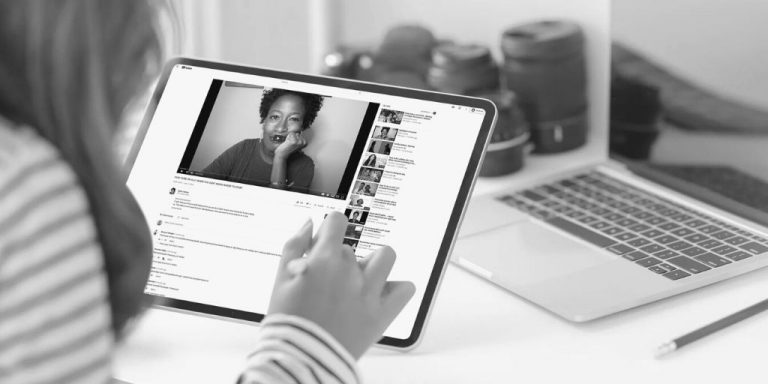
Ruth: But what got me motivated for the last four episodes… Oh, actually after that, I started doing stress management stuff.
Because, again, around COVID-19, stress became a huge factor. There was Kaiser Family Foundation had recorded the fact that people were feeling anxious and that COVID-19 was really having a negative impact on people’s mental health and I thought I would address that.
Then lately, I’ve been talking about race. And so one of my videos went kind of my-level of viral, not everybody-level viral, but about 3,800 people have seen it, and about 2,000 people saw it in the first 48 hours.
And it was basically me just spewing.
I literally had come home from working out, I’d walked 5 miles, came home and it was just on my brain as I was walking.
And I literally came in, didn’t wash my face, didn’t change my clothes, sat down in front of my phone and I just spewed something.
Ruth: And the thing is, the four points that I talk about in the video, I had put on a little square, those little squares that you put on Instagram, where you just put a say in Instagram?
Jennifer: Yeah.
Ruth: So it was just like a post on Instagram.
And after I posted it, I was like, “Oh, I have so much more to say about those four things.”
Then I had the video about it, and it resonated with people.
And suddenly my YouTube channel went from like, I don’t know, 60 subscribers to about 160, which then allowed me to customize my YouTube name.
I felt now that I owed people videos.
It’s like, “Oh, okay, I’ve got subscribers. Well, they subscribed to some things, so I should give it to them.”
So lately, I’ve been talking about allyship specifically on that channel. I think I have another video that I want to talk to white men about.
Don’t script your YouTube videos but have a few notes

Ruth: So for me, I don’t really write a script. This is how I did one video, I just have a-
Jennifer: A couple of little mugs.
Ruth: Yeah. I literally have one index card and then I sit down and I talk. I think for me, it has to resonate.
So if the topic resonates, then I don’t need a script, I just need to have an opinion on it. And so I just sit down, sit in front of my camera, put some powder on and be like, “Okay.”
Jennifer: I like that. And one of the things that I like most is that the video that really resonated most was the one in which you didn’t really prepare, you hadn’t washed your face, you just come in from a workout and you just sat down and hit record, and that’s what got you all the subscribers and attention. And you said just 48 hours.
That’s amazing because I think that, at least for me, I know that I’m always uncomfortable being on camera and feel like I need to prepare, very much like you in the sense that teleprompter would be my initial go-to, but I think it’s right.
Ruth: I literally use… Where’s my little clips? I use those little clips-
Jennifer: Like binder clips?
Ruth: Yeah. Binder clips.
I will sometimes when I used to, like, when I show up on TV or something or to remind myself, I would take binder clips and clip index cards to my laptop.
Jennifer: Because then you can see them.
Ruth: You can see them without going down and because my daughter also said, she’s like, “People can tell you’re reading.” So it’s great having a 20 something-year-old to tell me about YouTube etiquette.
And sometimes I’m like, “I don’t want to forget a particular opinion.” But I really feel what she was saying about scripting, because I think when it’s scripted, you feel more constrained.
And if you stumble over something, you feel like you got to go back and say it, whereas the person that’s watching you, they really don’t know what else you have to say, so you don’t have to feel like, “Oh, I messed up my lines, let me start over.” Which was what I was doing a lot, where it was taking you 3x, 4x, 5x to record a video. And I realized it really didn’t change much.
And so sometimes in the beginning, I’ll start and then I say, “Oh, I don’t like that start.” But once I’m two minutes in, I’m usually good. I’m like, “Fine. I’m just going to post it anyway.”
Subscribe to The Social Academic blog.
The form above subscribes you to new posts published on The Social Academic blog.
Want emails from Jennifer about building your online presence? Subscribe to her email list.
Looking for the podcast? Subscribe on Spotify.
Prefer to watch videos? Subscribe on YouTube.
Ruth doesn’t edit her YouTube videos, here’s why
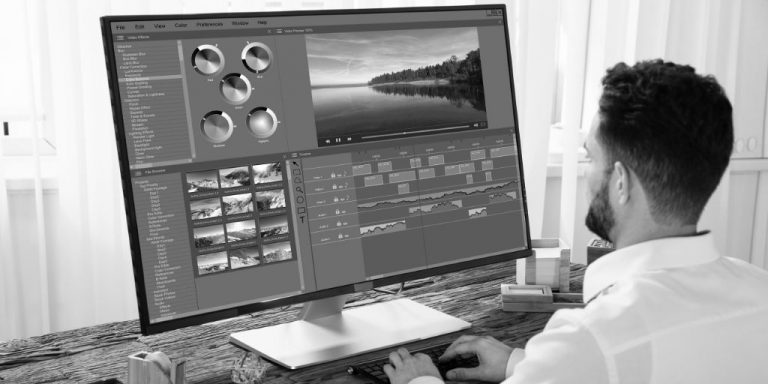
Jennifer: Can I ask, do you edit your videos?
Ruth: I tried, but I so stuck in little things. I did one video where I was trying to…
I think I have two videos on my YouTube channel where I was experimenting with editing and it just took me so many hours to put four words on.
But my daughter keeps saying to me, “Mom, if you practice, it gets really easy.” She’s like, “Adding a title will just be so easy,” because she did them in high school. They had a lot of assignments that had them doing iMovie and stuff.
And so I’m definitely thinking about doing more of it because I think even though my videos are only 5-6 minutes long, I think sometimes they could have a bit more punch visually in terms of grabbing attention, because at the end of the day, social media is about the media part of it.
People do want to see something that grabs their attention and if it grabs their attention, they’re more likely to click on it and listen to it.
Jennifer: That’s great. And just for everyone who’s listening, the nice thing about this conversation is that it didn’t really matter in the beginning whether there was editing, whether there was scripting or not, but very first video got her on The Today Show.
So there’s always room for improvement, but you can just start.
How to reach out and get booked on TV as an expert

Jennifer: Let’s see. So we did talk about The Today Show a little bit more, but I’d love to talk more about how you got your other TV bookings.
When you were posting, you said that you were getting up early in the morning to be on the news as a mental health expert. So how did those come about?
Ruth: Again, I’m one of these women, I just I throw things against the wall and see what sticks. Right?
My friends are like, “Why did you…”
I’m like, “I don’t know, it was two o’clock in the morning, it was an idea.”
And literally, that’s what happened. It was three o’clock in the morning, it was the Sunday before Spring Break, and so I knew I had the week off and I was just messing around.
And I was reading something about stress during COVID-19 and I was like, “Hmm, I’ve written about stress and I had a book coming out in May.” So I’d already written the book, I think I’d got it done like late January.
And so this was like early March and I sent an email… I was trying to find the contact information for TV stations.
And it’s really hard to find them, like really hard.
You start going down rabbit holes, you’re clicking on things.
It says, “Contact us.” You get there, there may be a form, there may not be.
Anyways, so I was looking for local San Francisco channels, the main ones, like the ABC, CBS, etc. And then I was on one called KRON 4, and it said they had an active link that just said, “If you have a story, contact us.”
And so I used that link and I said, “I would like to be on to talk about stress.” I had maybe
- 5-6 sentences of a bio
- the link to my webpage
- and LinkedIn page
Go to sleep, wake up at like 10 o’clock in the morning because it’s spring break, and realize I’d missed an opportunity to be on TV that morning.
So they got my email at 3:00 AM and somewhere around 8:30, they had emailed me to go, “We’d like to have you on today.”
Then my sister said, “See, early bird catches the worm.” She’s like, “If you would just get up early,” because I was asleep. I stay up late and sleep in all the time. So she was like, “This is how you miss opportunities.”
So then I emailed them right away and I said, “I can be on tomorrow.” And they said, “Okay.” So I get all done up, whatever, for tomorrow, and Trump had a news conference, like the 1st COVID-19 news conference, and so they postponed it.
The host called me out: “You actually emailed us and said I want to be on TV”
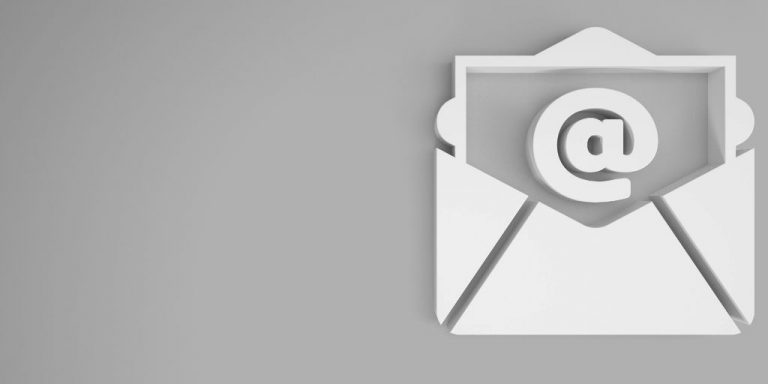
Ruth: The other interesting thing to note is that I had a ring light for weeks. My daughter had said, “You need a ring light.” She has a ring light on her phone. She’s an adolescent. She was a young adult.
So I’ve never used this ring light. It would have been sitting under my desk and the Sunday before, that same day when I reached out to them, I had put it together and tried to figure out how it works.
And 3 days later, I needed a ring light to be on TV.
So that was the Tuesday, and then they planned to put me on the Wednesday. And I got on and it was embarrassing in a way… So it was their morning TV show.
And the host literally called me out on TV, and she goes, “You actually emailed us and said, ‘I want to be on TV.'”
And I said, “Yeah. And here I am. You calling me out, but it worked because I’m sitting here talking to you.”
And so at the end of the segment, she says, “Oh, it’d be so great to have you on, we should have you on all the time.”
And I was like, “I’d be on all the time if you want me to.” And that was it, click Skype, hang up.
My landline rings and I pick it up and I say, “Hello.” Because nobody ever rings my landline, and they said, “Oh, you hung up too early. Would you like to be on tomorrow?” And I said, “I sure would.”
And so I came on the next day, same thing, I hang up after Skype, the phone rings, and they said, “We’d like to have you on indefinitely.” They were like, “We’ll reach out.”
And so the first 4 weeks I was on probably a couple of times a week.
So since early March, I’ve been on there around 12 times as a mental health commentator.
And then their news, their evening news person decided they wanted to have me on on the evening news.
And then that led to other things because like CBS-LA reached out and asked me to be on there.
And it’s just funny around technology as well because my Skype wasn’t really working for some reason on my laptop, and so I recorded my CBS-LA one on FaceTime.
When I told my friends, they were like, “You can FaceTime with that kind of quality? It looks studio quality.” They were like, “Just use FaceTime, it works for us.”
And so again, that’s what I was saying about how social media has changed things because now we can do that I can be in Oakland and be on my phone and be on TV.
That’s not how it was 10 years ago.
Talking equipment for being on tv: a ring light, built-in webcam, and standard mic
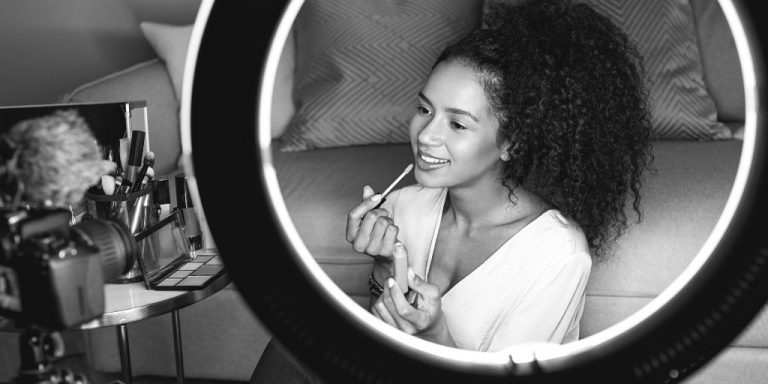
Jennifer: In terms of equipment, you had a ring light, and is that it?
Ruth: I have a ring light, and my MacBook Air might be 3-4 years old, and an iPhone 11.
Jennifer: And you use the built-in camera for your Air Book and for your camera?
Ruth: Yeah. And I don’t even use… My first time on I had the earphones with the cord and my friends saw it when I posted it, and my friends were like, “You cannot be on with that.”
Jennifer: On television.
Ruth: Yeah. That was so funny, they sent me a gift of AirBuds. They were like, “Here’s to your TV success.” I did buy a microphone, I don’t want to necessarily-
Jennifer: A lavalier mic?
Ruth: Yeah, like this thing, but I still haven’t used it yet because nobody has told me that the quality was bad.
So even the TV, they were like, “Oh, it’s fine.” And they’re very picky about sound. And they were like, “No, it’s fine.”
So I was like, “Okay. Well, I’m not going to mess with it then since it works.”
Jennifer: If you’re fine, I’m fine.
Ruth: Yes. And I turn Facebook Lives without the microphone. I did a segment for the Commonwealth Club. I did a panel yesterday with the Commonwealth Club California, and I didn’t use a microphone and they were fine. So I’m like, “Okay, as long as it’s quiet in the background.”
Jennifer: That’s great. Thank you so much for sharing that, especially about the equipment. That’s such a good tip to know.
Ruth: Yeah. Also, because I Googled equipment for on air and a lot of places just said, “Start with the basic stuff, especially if you’re not separating sound from visuals.”
But they were like, “If you want to do like a podcast where the sound, you need better quality sound and you need better-
Jennifer: Because it’s audio only, right?
Ruth: Because it’s audio only. Right.
And so that’s why I bought it, but I don’t even know how it works really. So I’ll have to see how it works.
But I just think that… I had so many barriers in my head about what it would mean to do this in terms of setup and recording and all of that and realizing that I had what I needed.
How to be comfortable on camera, being on video

Jennifer: So my next question, it’s kind of personal. I am always uncomfortable on camera, this is one of my first times where I’m doing a full recording for the interviews on camera. I have another interview scheduled next week, but it’s always a little anxiety provoking for me.
So you seem very comfortable on camera, do you have any tips?
Like how do you get comfortable before you’re going to shoot?
Ruth: One, I think it takes practice.
Part of it is, being a professor, you’re in front of an audience all the time. I tell people, “Being a professor is show business. If you’re not putting on a show, people are probably going to sleep.” Because I used to fall asleep with the professors who just taught me the information, especially in some of the boring topics that I teach.
I teach research, which students come in and they’re like, “Oh God, I don’t want to do this.”
So my job, I always feel is to make it engaging, to make the metaphors I use resonate, so we’re not just talking.
Ruth: It’s like, “Oh, okay. If we think about efficacy and effectiveness, let’s talk about a condom.” And then people will like… I’ll actually tell my students to remember the story I use? And they’ll be like, “Oh yeah, I remember the concept.”
And then I’ve done modeling. So that’s something that I do on the side, which is also weird because not a lot of professors model. And so that also got me comfortable in front of the camera.
I think being in front of the camera as a model, you feel very self-conscious because you’re trying to portray something and you’re very aware of your body and your face, and did you do it right?
I think my first concern around being on camera was makeup, and I felt like I don’t even know what makeup looks like for bright lights.
I’d been once or twice on TV, and then the kind of makeup they put on was not necessarily my forte. And so that was kind of self-conscious.
And so after my first two TV appearances, I fixed that. I just looked at it in a way, “Okay, that’s kind of bright, you need more browns.”
And it was funny because I brought this brown eye shadow once and I was like, “Why did I buy brown eye shadow? I’m brown. It’s not going to show.” And then I realized that it did.
Jennifer: But for the light, it makes big sense.
Pro tip: High-pigment eyeshadows and powders will stand out more in bright light settings.
What to wear on tv: avoid patterns and distracting jewelry

Ruth: Exactly, it makes a big difference. And then also I Goggled what to wear on TV. And I’m glad that I did because my wardrobe is not TV friendly.
Jennifer: Do you have lots of pattern?
Ruth: I have a lot of black and white graphics. I have a lot of black, a lot of white, and prints.
Then I was like, “Oh crap, what am I going to wear on TV?”
So the first couple of times I had this one top and then my sister goes, “So are all your clips going to have the same top in them?” And I went, “Oh, okay. Let’s go see what else I have.”
And so some of them I actually wore a dress just because I wanted the top part to be different even though nobody could see me in a dress.
Jennifer: Of course, that’s a great idea.
Ruth: Yeah. So even though nobody could see me in a dress, I was like, “Well, we just get a dress.”
And then I added jewelry and then I read this thing about jewelry shouldn’t be distracting.
And so I had to do some work to now figure out what I want to look like on screen.
Jennifer: That’s great. Thanks for sharing that. And I think also one of the things it sounds like is that whereas you have the equipment that you were concerned about or anxious about maybe needing, you already had all that stuff.
Then you found that there were other things that helped you feel more comfortable. And part of it was learning the makeup and changing that up, and part of it was practice. So thanks. Yeah, definitely, that’s helpful.
Subscribe to The Social Academic blog.
The form above subscribes you to new posts published on The Social Academic blog.
Want emails from Jennifer about building your online presence? Subscribe to her email list.
Looking for the podcast? Subscribe on Spotify.
Prefer to watch videos? Subscribe on YouTube.
Preparing to be on video in advance

Ruth: And I think also feeling as if you’re prepared, so one of the things that start happening with the TV people, and it happened a couple of times, and then I said, “You guys can’t do this to me.”
I got called a couple of times literally with 45 minutes to wake me up. I’m asleep, the phone rings, it’s 7:30 in the morning and they go, “You should be on-“
Jennifer: We need you on.
Ruth: “… in 45 minutes.” And I was just like, “Okay, I can.” And I’m just jumping up.
And then I remember this one segment where they started showing a video of people in Florida on the beach, and I remember going, “What are they going to ask me?”
I had no idea what they were showing the video for.
And then they asked me about young adults, why they want to rebel and go on spring break, etc.
And yes, I could answer that because I’m a social worker and I’ve worked with adolescents for a long time, but I asked them to give me advance notice because I was like, “If I know what I’m going to talk about, I can seem more informed.”
I can actually educate the audience, I can have some data like, “Oh look, the Mayo Clinic found this.” Or, “Harvard found that.”
Ruth: I won’t have that off the top of my head if you just sit me down and here comes whatever the anchor wants to talk about now.
So I think also preparing is part of making me feel comfortable, like you shared questions with me, and that allows me to know, “Oh, okay, I know what I’m going to be talking about.” So that really makes a difference.
Jennifer: Now, when you realized that that was something that you needed time to prepare, can I ask, how did you go about asking for that or communicating that need to the studio?
Ruth: That’s actually a good question.
I just emailed them and I said, first of all, I wanted to know if you get paid, I don’t know anything about media. So I had a friend who was a journalist, I’m like, “Do they pay you for this?” And he’s like, “Generally, no, but they will promote a product.” And I was like, “Oh my book.” So I had them promote, I said, “I’m a graphic of the cover page.” And they said they would do that.
And they said they would send me advanced notice. Sometimes that advanced notice was just email.
I also then started pitching them stories.
Ruth: Once I was on, I would… I remember the whole work from home things started getting crazy and I’ve been working from home for seven years. So I pitched them and I sent them an email and go, “I would love to talk about working from home.” And they were like, “Great idea.”
I said, “I’d like to talk about parenting.” Because my sister and I did a YouTube video around stress for parents, because my sister is a parenting educator and I was like, “We should do a YouTube video.” That one’s actually longer than most of my YouTube videos. So that’s about 12 minutes long.
And so I started pitching them ideas and sometimes they would take me up on it and sometimes they wouldn’t.
But my dad always said, “Open mouth get fed.” So I just open my mouth. Because what are they going to say? If they say no, it’s fine.
Jennifer: Yeah. It doesn’t take them any time to respond to, it sounds like probably a couple sentences of a pitch, but it’s not very long.
So you’re helping them think of ideas or giving them ideas that they can just say, “Well, we don’t need that right now.” And that makes it easy for them.
Ruth: Exactly. You just nailed it.
So my friend was a journalist, actually on that station, he retired 2 years before and he said to me, all the time he goes, “Journalists are always looking for stories. So if someone brings you a story, that’s just one less story you have to look for.”
And I think that was a really important message for me because at first, I just thought, “Okay, they’ll find me,” but it’s you offering them something.
And then I did the same with Fast Company and getting an article. I had this thing where for 2020, I said, “I wanted to be on TV doing commentary and I want it to be in a business magazine.”
And so same thing. I went looking for BusinessWeek, our folks could not find their email.
I found the email for Fast Company, sent something to the editor, they said like 5-7 days, I didn’t hear back.
I emailed them. And I said, “You know, if you don’t want it, just let me know so I can put it somewhere else.”
And the editor was like, “Oh my gosh, actually this is perfect timing, we’re running on Friday.”
Jennifer: Wow. That’s great.
Ruth: Yeah. And so they ran it and then I came back to her and said, wait a minute. Okay. They did it once, let’s see if they’ll do it again.
And so I still have a pitch right now with them, I just don’t have time right now, but I got three pieces in related to COVID in Fast Company.
So I think what’s important is for people to offer themselves as a resource.
And it might take a few hits, but again, like I say, journalists are looking for stories and we can help them with their job.
Subscribe to The Social Academic blog.
The form above subscribes you to new posts published on The Social Academic blog.
Want emails from Jennifer about building your online presence? Subscribe to her email list.
Looking for the podcast? Subscribe on Spotify.
Prefer to watch videos? Subscribe on YouTube.
Your online presence can speak for itself: a bio, website, and LinkedIn profile

Jennifer: The other tip that I think that you shared is to keep it shorter. When you said that you initially reached out to the local TV station in San Francisco, that was just a short bio and links to your LinkedIn and what else?
Ruth: Yes. And my website.
Jennifer: Your website.
Ruth: Yeah. And I think for those things what people don’t realize, especially with LinkedIn is that you can put clips of your work on LinkedIn.
And a lot of people don’t know that, and my friends are like, “Wait, you have video on your LinkedIn?”
I even put the order of the videos so that they can see my work so that when people find me on LinkedIn, they can see me on TV on LinkedIn. Because I think that’s important because they want to know what you look like, and they want to know what you sound like on TV before they put you on.
Jennifer: That’s great to know. And I liked that also, it sounds like that your LinkedIn and your website, it spoke for itself.
You didn’t necessarily need to go out and pitch yourself as this amazing expert because those profiles that you had were already speaking for itself. And so they were able to visit and make that decision.
Why video is important, even on a personal website
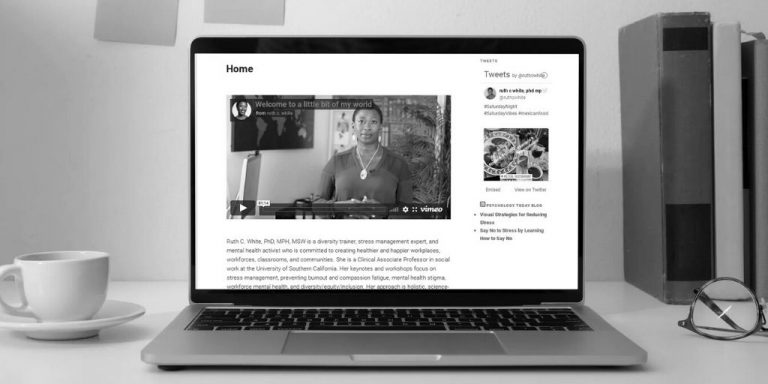
Ruth: Yes. And it was funny, I have a friend who had a YouTube channel teaching people how to code, and she was the first person that told me I needed video on my website.
And I said, “What am I going to do?”
And she says, “Just put an introduction.”
I said, “I never see websites like that.”
And she’s like, “That’s my point.” And I went, “Oh.” Because she’s like, “That will just stand out.”
And literally on my website, I think I have an intro that’s like, “Hey, my name is Ruth White, welcome to my website.” But I thought it was corny, and she just said, “You know, it just gives you a clue to who the person is rather than just seeing a picture.
Jennifer: Yeah. That’s totally, it’s more dynamic than just a headshot, which is what I have on my website right now, but I’m going to be changing that, especially after talking to you.
It sounds like just that personality can make a huge difference with how likely people are to reach out and actually connect with you, especially when you’ve reached out to them first. So that’s great.
Ruth: Yes. I definitely think… And my website is something I do, it’s old. I need to upgrade it, but I just haven’t gotten around to pay somebody to do it. And every time I think about paying somebody and I’m like, “Oh my gosh, now I have to sit down with them and they have to understand my design ideas.” But my website is really old, but it serves its purpose.
Jennifer: It seemed very clean, I understood a lot about you when I was able to visit your website and all of the pages. It’s very clean, it’s understandable, and that makes huge difference.
Ruth: Yes, and I think what happens is that, I said to somebody, “Do people really hire you because you have a flashy website?”
Like in the work that I do. Like is somebody’s going to bring me on TV because, “Oh my goodness, her website was amazing.” No.
Jennifer: They brought you on TV from your vlog where you were sitting in front of a camera and being yourself.
Ruth: Exactly.
And so I have friends, they’re like, “Oh, it’s going to cost me $2,000 for a website.”
And I’m like, “Your website, unless you’re actually a creator of some kind and people want to see your creativity, people want to find out who you are, what you do, and what other people think about you.” And if you can just do that as a basic, then yeah. I have friends who right like, “Ruth, you need to upgrade it.”
And I do, but at the same time, I don’t think that’s what’s driving… flashy graphics, that’s not what’s making people find me.
Jennifer: No, your work is what’s making people find you, the articles and the videos that you’re putting out is making people find you, and the right people.
Ruth: Yes, the right people. Because it’s true, I have friends with really nice websites and they do stuff, but they’re always…
People come to me literally and go, “Who’s your PR person?”
I’m like, “I don’t have one.”
And they’re like, “How do you get on TV?”
I’m like, “Literally, this is how I get on TV.” And I think that more people need to understand the dynamics of it.
Do you need a personal website? Are you ready to do-it-yourself? Check out my step-by-step academic personal websites guide.
‘You wrote this blog post and it really connected with us’: how public writing can reach the right people

Ruth: I started realizing that journalists are kind of lazy, but they need-
Jennifer: They are very busy.
Ruth: They’re very busy, right? And it’s when I say lazy, it’s like, they don’t want to have to spend two hours digging to find the expert. They used to use journal articles.
Now, I have asked, “How do you find me?” Because I was very fascinated.
First time, BBC World Service called, I thought it was a friend joking. I was like, “Okay.”
And they said, “We would like to have you on our show called The Why Factor.
And I said, “Okay, about what?”
And she said, “About race.”
Now, that made me almost laugh inside because I was thinking, “There are so many race scholars in the United States who have written amazing bestselling books. Why do they want me as their featured expert?”
Ruth: And she said to me, “You wrote this blog post called The Race Card, and it really connected with us.”
And I went, wait, “I wrote a blog post, on my Psychology Today blog, and that’s getting me on BBC World Service. What?!”
My sister goes, “What?”
And I was like, “I asked.” I was like, “She told me, that’s how she found me.”
Jennifer: I love that you asked.
Ruth: I asked her because I was so… At first, I thought like, “What?”
Because y’all I write about race, but again, I’m not writing books about race. I don’t do research about race. I’ve taught the subject, but they just liked my angle.
And so I wasn’t even just one comment, they had me for the whole show. I did it on my iPhone 7 at the time or whatever.
And I think it’s really, I want to encourage people to not be intimidated by that whole media process. Because that’s been my experience, is that it’s not as complicated as people think it is.
The thing about hiring a PR person is you got to pay them regardless of where they’re not they get you on.
Jennifer: That’s very true.
Ruth: So you have to pay them a retainer, they do their work and you still might not get on, but you paid them.
Being on TV doesn’t bring you money right away, media is an indirect link to income

Ruth: And getting on media helps you get on more media, but it’s sometimes it’s not a direct link to income, it’s an indirect link to income.
So being on TV doesn’t bring you money right away. It just helps build your brand.
Jennifer: Absolutely. Because as you said, and you asked them, you weren’t sure if you were going to get paid for those TV spots, you had to ask your friends and ask the network whether that was something that they even did.
Ruth: Yeah. I didn’t know. And I think I also was intimidated to ask in a way..
Jennifer: I would be too.
Ruth: …and my friend was like, “Ask them. And my friend was just like, “Ask them.
And I was like, “Yeah, that makes sense, just ask them.”
If I say, “Do I get paid?” Are they going to say, “No, we don’t want you on TV anymore.”
And it was right, he was like, they’ll just tell you yes or no.
Jennifer: That’s great.
Ruth: I’m like, “Yeah, that’s true.”
Ready for a YouTube channel? Advice for academics on YouTube

Jennifer: All right. So my last question is, for new faculty or graduate students who are thinking about getting into YouTube, recording some videos, what advice do you have to share with them?
Ruth: I say, find what you’re passionate about.
Because then the conversation that you’re having comes off more natural, because it’s just you talking like you’re talking to your friend.
And that’s what I do, I’m looking at the camera and I always say it’s like me at brunch spewing with my friends with my little opinionated self.
And I think if you’re passionate about that, that comes across and it makes people want to keep listening, because people have short attention spans. I was reading something from YouTube itself, from the YouTube Creator channel or whatever, and they said something like, after four minutes, people start dropping off. And I was like, “What, four minutes?”
Jennifer: That’s so short.
Ruth: It’s so short. And that’s why I did the 5-6 minute thing, because then I thought, “Well, after I’m done saying what I’m saying, I can talk about subscribe to my channel or whatever, but they will get the message.”
And that’s the other thing, to note that it doesn’t have to be an hour, that a lot of people are not going to… It doesn’t matter how amazing they are.
And that’s why TED Talks are… Some TED Talks are 12 minutes, and these are amazing speakers who have practiced and they’re on a stage, but TED knows that after about 20 minutes, we’re gone, bye-bye.
So, to also take that into consideration that, think about how long you sit and watch something and whether or not somebody else would do that, especially if you don’t have a guest.
So like you and I are in conversation, if I’m having a conversation, it’s much different than me just sitting and talking to a camera.
Jennifer: That makes a lot of sense.
And it’s probably also, it would be harder to sustain like a 30-minute, even 20-minute video when what you’re going off of is notes. Maybe you could get used to that, I’m sure podcasters do, but on video, that feels more challenging.
Subscribe to The Social Academic blog.
The form above subscribes you to new posts published on The Social Academic blog.
Want emails from Jennifer about building your online presence? Subscribe to her email list.
Looking for the podcast? Subscribe on Spotify.
Prefer to watch videos? Subscribe on YouTube.
To make people listen, keep it short and accessible

Ruth: Yeah. I also thought that in academia, we say way too much sometimes. Like I have friends who always said, “How do you write a 500-word op-ed?”
And I went, “Because you just say what you got to say and be done with it.” And they’re like, “Yeah, I just can’t edit it.”
I used to edit so many of my friends’ pieces because they were like, “I just can’t get it down below 1,200 words.” I’m like, “Nobody goes through The New York Times Letter to the Editor or the editorial page to read your thesis. No.”
And also to make the words accessible. I’m not going to sit here and talk about the intersectionality of whatever, whatever, trends, blah, blah, blah. The only people that would listen to that are people who study that.
So it’s also important, I think, for academics to remember to make things accessible.
Because the more people that can understand what you’re saying, the more people that will actually listen to what you’re saying.
Jennifer: Great. That was such a good tip.
I feel like being yourself, it sounds like really a huge drive. And in terms of how you appear on video, how you appear on TV spots, and how you feel comfortable also when you’re talking.
And what you’re talking about, it’s all about what you’re interested in and what you can bring to the table and what you can share with people, and I love that.
Ruth: Yeah. And I think that’s, what’s really important, like you say, is to bring yourself, if this is not how you would talk, normally you are going to look awkward, and that’s what my daughter noticed.
She was like, “You look awkward, you look nervous.” She’s like, “You talk to people all the time.” And I do, I talk to strangers.
So she’s like, “You talk to strangers, you just randomly talk to people, do that. Just do that and it will resonate with people.”
And I think that’s really important to not try and like, “Oh, I want to be like this person, or I want to be like that person,” be the person that you are.
Discover books and blogs by Ruth C. White

Jennifer: Great. Thank you so much. Is there anything that you’d like to add? You’re welcome to let us know about your book or anything else that’s coming up.
Ruth: So I do have 2 books, well, this is the latest one which is Everyday Stress Relief. And then the one that’s really popular is The Stress Management Workbook, which a lot of people find useful. It just basically walks you through developing your own stress management techniques, etc.
Oh right, my YouTube channel is Rant.Rave.Reason. You can find it on there, Ruth C. White. If you go into YouTube and look for Ruth C. White, you’ll find it there. And I think that’s it.
And I have a Psychology Today blog called Culture in Mind.
You can also find me on Medium because I took my Provoking Policy blog to Medium because my friend was like, “BlogSpot is not as popular as Medium.” So now, you can find me, Ruth C. White on Medium. And again, I write about social commentary, etc.
Jennifer: Awesome.
Ruth: Thanks for having me.
Jennifer: Yeah, this was so much fun. I’m going to include all the links to your books and to your channels, definitely in the blog post and below the video.
Ruth: Thank you.
Jennifer: That was such a good conversation. I so appreciate all of your expert advice and telling all of those stories about how you got on television and starting your YouTube channel. This was great.
Ruth: Thank you so much.
I’ve been talking with Dr. Ruth C. White about how she started out on YouTube. And, we got into some great advice like
- don’t stress too much about the equipment
- be yourself
- no need to script it out
- prepare in advance with a few notes
Ruth also got into how things worked when booking her television spots. From pre-interviews to how to follow-up, this interview was packed full of actionable advice for you.
Be sure to check out Ruth’s YouTube channel, Rant. Rave. Reason.
And, if you haven’t checked out video content from The Social Academic on YouTube yet, you’re missing out! I have live interview guests, quick tips, and more.
Thanks for joining me for this interview with Dr. Ruth C. White. Until next time, check out my guest post on how video can help your personal website.
Subscribe to The Social Academic blog.
The form above subscribes you to new posts published on The Social Academic blog.
Want emails from Jennifer about building your online presence? Subscribe to her email list.
Looking for the podcast? Subscribe on Spotify.
Prefer to watch videos? Subscribe on YouTube.
Bio for Ruth C. White

Ruth C. White, PhD, MPH, MSW is a thought leader, change catalyst and advocate in mental health and diversity/equity/inclusion. Dr. White is a Clinical Associate Professor in the Suzanne Dworak-Peck School of Social Work at the University of Southern California. Professor White has worked as a social worker while living in the UK, USA and Canada, and has collaborated with non-profits, corporations, governments, and academic institutions across the globe.
Inspired by her own journey of recovery and resilience with bipolar disorder, Dr. White is a mental health activist and advocate. As a DEI consultant she supports organizations in becoming more equitable and inclusive.
Her books include
- The Stress Management Workbook: De-stress in 10 minutes or less
- Everyday Stress Relief: Essential techniques to boost resiliency and improve your health
- Bipolar 101
- Preventing Bipolar Relapse
Dr. White also writes for Thrive Global, authors the popular Culture-in-Mind blog on the Psychology Today platform, and writes social commentary on Medium.
During COVID19, Dr. White is a mental health contributor on KRON4 TV Bay Area and has written several related articles for Fast Company. She and her work have been featured on The Today Show, BBC World Service, national radio shows, and in popular media such as Marie Claire, Women’s Health, Vanguardia (Mexico), and Woman’s Day.
Subscribe to Ruth’s channel, Rant. Rave. Reason., on YouTube.
Jennifer van Alstyne View All →
Jennifer van Alstyne is a Peruvian-American poet and communications consultant. She founded The Academic Designer LLC to help professors build a strong online presence for their research, teaching, and leadership. Jennifer’s goal is to help people feel confident sharing their work with the world.
Jennifer’s personal website
https://jennifervanalstyne
The Academic Designer LLC
https://theacademicdesigner.com
